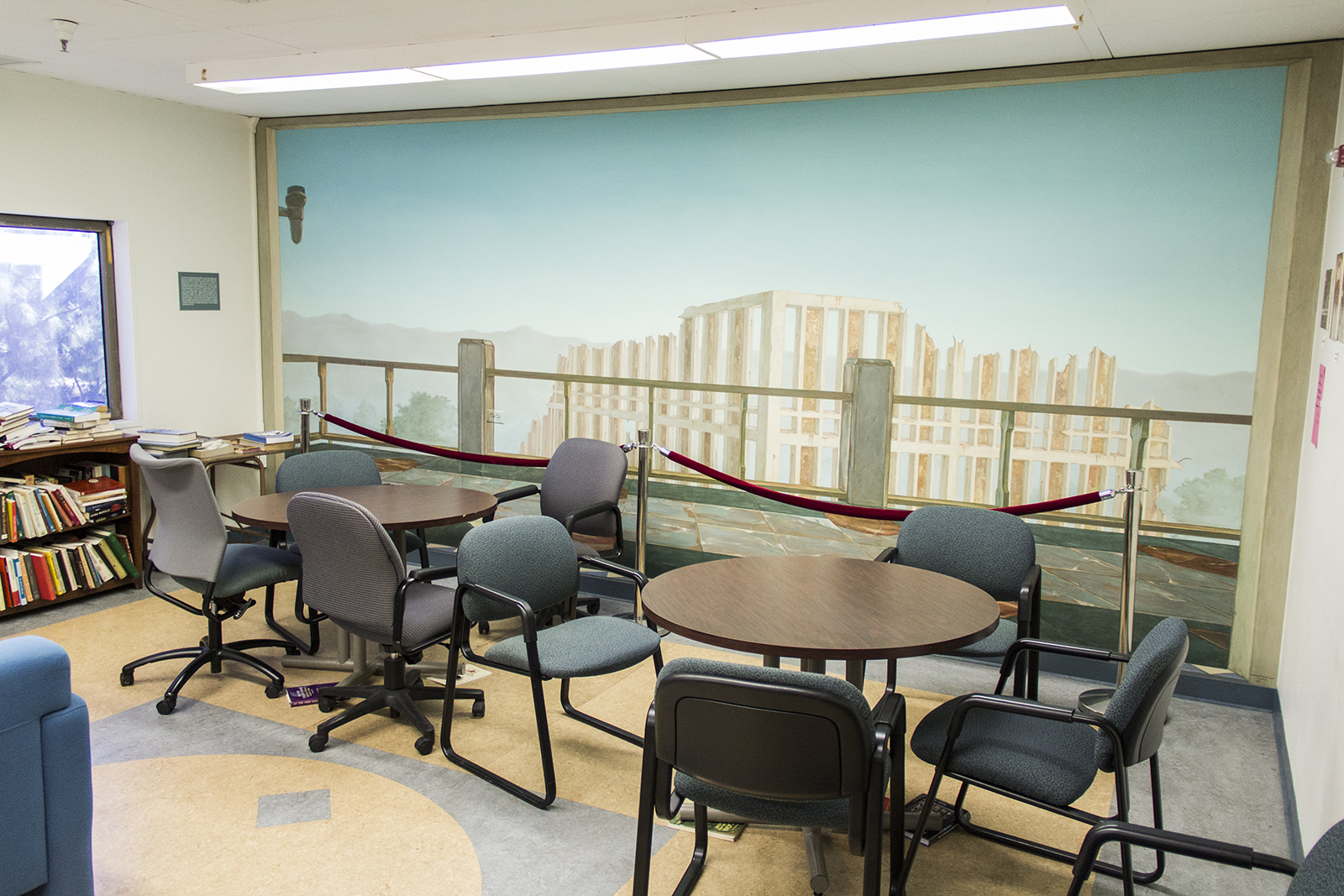Q&A: History professor talks about Schoonhoven mural’s revival

“S.P.Q.R.,” a mural painted by UCLA graduate Terry Schoonhoven in 1974, was rediscovered as one Schoonhoven and the L.A. Fine Arts Squad’s best preserved works. The mural depicts Schoonhoven’s vision of UCLA’s apocalyptic future.
(Angie Wang/Daily Bruin senior staff)
By Natalie Green
Aug. 18, 2014 3:26 a.m.
In the distant future, all that is left of the pods and modern nuances of the Charles E. Young Research Library is a stripped wooden structure and devastation. An entire wall of the UCLA history department’s student lounge is devoted to this scene, with the mural, titled “S.P.Q.R.” or “the Senate and People of Rome,” looking out over the ruins of the research library from Bunche Hall.
Commissioned for $500 in 1974, the mural painted by UCLA almunus Terry Schoonhoven and his organization, the L.A. Fine Arts Squad, was completed a year later. After four decades of dirt build-up and scratches, the mural was restored last year by art conservator Amy Green and was rediscovered as one of the best preserved works of Schoonhoven, who passed away in 2001.
The Daily Bruin’s Natalie Green sat down with Thomas Hines, a research professor of history and architecture and urban design and one of the members of the committee who commissioned “S.P.Q.R.” decades ago and worked on its recent reestablishment.
Daily Bruin: In 1969, Terry Schoonhoven and an artist named Victor Henderson began a collaboration that became the L.A. Fine Arts Squad. What was their goal?
Thomas Hines: They were all committed to this idea of public art, later called street art, that ordinary people could have access to. But street art has connotations of graffiti, and (instead) they really had elevated conceptions of art on walls as murals.
DB: How did the inspiration come about to commission Schoonhoven and the L.A. Fine Arts Squad to paint an indoor mural in Bunche Hall?
TH: In 1974, the chair of the history department, Robert Burr, talked to me about redoing the student lounge because he had gotten money from Murphy Hall and (was planning) what to do with it. The student lounge needed a lot of things, but I think what he had in mind was furniture and draperies and things like that.
The committee quickly formed: myself, Fred Notehelfer (then-vice chairman of the history department), Gary Nash (research professor of early American history) and the then-undergraduate advisor Sylvia Dillon. We talked about it and said it’s so boring to think about buying furniture, why don’t we (use) the money for something really nice and unusual and let’s see if Schoonhoven and the L.A. Fine Arts Squad will paint this wall?
DB: Why did the committee decide on Schoonhoven as the artist?
TH: He just popped into mind. I was a big fan, I had seen his other pieces. When we said the word mural and had this big blank wall, I don’t think any other person’s name occurred to us. It seemed obvious and when we asked him and he said yes, well, things fell into place almost too easy, almost too quickly.
DB: Did the committee have any say in the apocalyptic subject matter of the mural?
TH: We all knew as art historians (and related fields) that if we commissioned a good artist we would have to take a step back and let that person decide what it was about. We couldn’t give them the subject, but we suggested that there should be some allusion to UCLA.
Some people see it as a very sad, tragic, gloomy thing, and I can agree to that in some way, but it’s also very funny, there’s an element of irony there. Schoonhoven was sardonically thinking about a view from this spot in what is now Bunche Hall in some future century after an earthquake has taken the city away.
DB: Why does the mural today hold a special place in Schoonhoven’s history of over 40 murals painted throughout his lifetime?
TH: Mural art is an ephemeral form. It is outside in the elements. The point of this whole restoration is that the mural in our history department turns out to be the best preserved of all of Schoonhoven’s murals and maybe the only one that is well preserved enough to see.
DB: How did this recent renovation and rediscovery of the mural begin?
TH: Over the years as faculty changed and students changed and generations came and went, people didn’t seem to remember what it was all about. I just think it was not something that engaged people very much. And I noticed several years back that people were jamming chairs and tables against it and there were some nicks and scratches. At that time, there were talks about redoing the department lounge, and I was worried about the mural.
I went to talk to the current chair of the history department, David Meyers. I told him the story and explained what the mural was about and the importance of the L.A. Fine Arts Squad. He got interested, and said “we need to protect this” and we contacted Amy Green, an art conservator and she cleaned it and restored it.
DB: What can today’s students do to preserve and better understand “S.P.Q.R.?”
TH: Well, they can not run chairs and tables against it. And they can do what we ask you to do all the time, which is sit and look and think. We believe as historians that history is important and that the more you know the better you’re able to understand the world.


